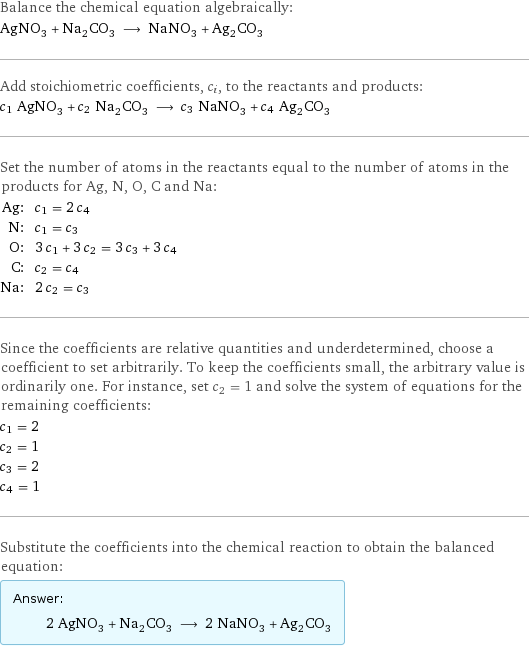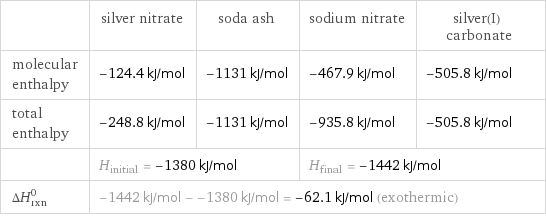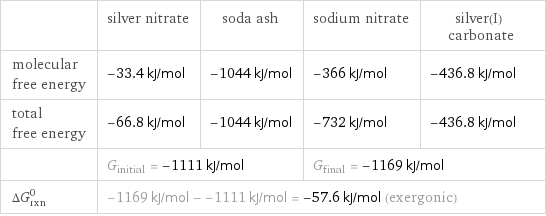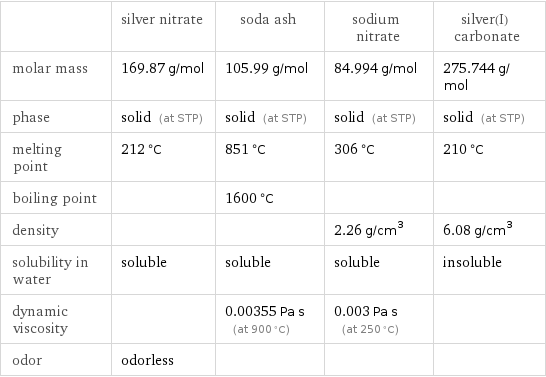Input interpretation

AgNO_3 (silver nitrate) + Na_2CO_3 (soda ash) ⟶ NaNO_3 (sodium nitrate) + Ag_2CO_3 (silver(I) carbonate)
Balanced equation

Balance the chemical equation algebraically: AgNO_3 + Na_2CO_3 ⟶ NaNO_3 + Ag_2CO_3 Add stoichiometric coefficients, c_i, to the reactants and products: c_1 AgNO_3 + c_2 Na_2CO_3 ⟶ c_3 NaNO_3 + c_4 Ag_2CO_3 Set the number of atoms in the reactants equal to the number of atoms in the products for Ag, N, O, C and Na: Ag: | c_1 = 2 c_4 N: | c_1 = c_3 O: | 3 c_1 + 3 c_2 = 3 c_3 + 3 c_4 C: | c_2 = c_4 Na: | 2 c_2 = c_3 Since the coefficients are relative quantities and underdetermined, choose a coefficient to set arbitrarily. To keep the coefficients small, the arbitrary value is ordinarily one. For instance, set c_2 = 1 and solve the system of equations for the remaining coefficients: c_1 = 2 c_2 = 1 c_3 = 2 c_4 = 1 Substitute the coefficients into the chemical reaction to obtain the balanced equation: Answer: | | 2 AgNO_3 + Na_2CO_3 ⟶ 2 NaNO_3 + Ag_2CO_3
Structures

+ ⟶ +
Names

silver nitrate + soda ash ⟶ sodium nitrate + silver(I) carbonate
Reaction thermodynamics
Enthalpy

| silver nitrate | soda ash | sodium nitrate | silver(I) carbonate molecular enthalpy | -124.4 kJ/mol | -1131 kJ/mol | -467.9 kJ/mol | -505.8 kJ/mol total enthalpy | -248.8 kJ/mol | -1131 kJ/mol | -935.8 kJ/mol | -505.8 kJ/mol | H_initial = -1380 kJ/mol | | H_final = -1442 kJ/mol | ΔH_rxn^0 | -1442 kJ/mol - -1380 kJ/mol = -62.1 kJ/mol (exothermic) | | |
Gibbs free energy

| silver nitrate | soda ash | sodium nitrate | silver(I) carbonate molecular free energy | -33.4 kJ/mol | -1044 kJ/mol | -366 kJ/mol | -436.8 kJ/mol total free energy | -66.8 kJ/mol | -1044 kJ/mol | -732 kJ/mol | -436.8 kJ/mol | G_initial = -1111 kJ/mol | | G_final = -1169 kJ/mol | ΔG_rxn^0 | -1169 kJ/mol - -1111 kJ/mol = -57.6 kJ/mol (exergonic) | | |
Equilibrium constant
![Construct the equilibrium constant, K, expression for: AgNO_3 + Na_2CO_3 ⟶ NaNO_3 + Ag_2CO_3 Plan: • Balance the chemical equation. • Determine the stoichiometric numbers. • Assemble the activity expression for each chemical species. • Use the activity expressions to build the equilibrium constant expression. Write the balanced chemical equation: 2 AgNO_3 + Na_2CO_3 ⟶ 2 NaNO_3 + Ag_2CO_3 Assign stoichiometric numbers, ν_i, using the stoichiometric coefficients, c_i, from the balanced chemical equation in the following manner: ν_i = -c_i for reactants and ν_i = c_i for products: chemical species | c_i | ν_i AgNO_3 | 2 | -2 Na_2CO_3 | 1 | -1 NaNO_3 | 2 | 2 Ag_2CO_3 | 1 | 1 Assemble the activity expressions accounting for the state of matter and ν_i: chemical species | c_i | ν_i | activity expression AgNO_3 | 2 | -2 | ([AgNO3])^(-2) Na_2CO_3 | 1 | -1 | ([Na2CO3])^(-1) NaNO_3 | 2 | 2 | ([NaNO3])^2 Ag_2CO_3 | 1 | 1 | [Ag2CO3] The equilibrium constant symbol in the concentration basis is: K_c Mulitply the activity expressions to arrive at the K_c expression: Answer: | | K_c = ([AgNO3])^(-2) ([Na2CO3])^(-1) ([NaNO3])^2 [Ag2CO3] = (([NaNO3])^2 [Ag2CO3])/(([AgNO3])^2 [Na2CO3])](../image_source/a4daf5ec6169d87938a3c9e2936a2ce4.png)
Construct the equilibrium constant, K, expression for: AgNO_3 + Na_2CO_3 ⟶ NaNO_3 + Ag_2CO_3 Plan: • Balance the chemical equation. • Determine the stoichiometric numbers. • Assemble the activity expression for each chemical species. • Use the activity expressions to build the equilibrium constant expression. Write the balanced chemical equation: 2 AgNO_3 + Na_2CO_3 ⟶ 2 NaNO_3 + Ag_2CO_3 Assign stoichiometric numbers, ν_i, using the stoichiometric coefficients, c_i, from the balanced chemical equation in the following manner: ν_i = -c_i for reactants and ν_i = c_i for products: chemical species | c_i | ν_i AgNO_3 | 2 | -2 Na_2CO_3 | 1 | -1 NaNO_3 | 2 | 2 Ag_2CO_3 | 1 | 1 Assemble the activity expressions accounting for the state of matter and ν_i: chemical species | c_i | ν_i | activity expression AgNO_3 | 2 | -2 | ([AgNO3])^(-2) Na_2CO_3 | 1 | -1 | ([Na2CO3])^(-1) NaNO_3 | 2 | 2 | ([NaNO3])^2 Ag_2CO_3 | 1 | 1 | [Ag2CO3] The equilibrium constant symbol in the concentration basis is: K_c Mulitply the activity expressions to arrive at the K_c expression: Answer: | | K_c = ([AgNO3])^(-2) ([Na2CO3])^(-1) ([NaNO3])^2 [Ag2CO3] = (([NaNO3])^2 [Ag2CO3])/(([AgNO3])^2 [Na2CO3])
Rate of reaction
![Construct the rate of reaction expression for: AgNO_3 + Na_2CO_3 ⟶ NaNO_3 + Ag_2CO_3 Plan: • Balance the chemical equation. • Determine the stoichiometric numbers. • Assemble the rate term for each chemical species. • Write the rate of reaction expression. Write the balanced chemical equation: 2 AgNO_3 + Na_2CO_3 ⟶ 2 NaNO_3 + Ag_2CO_3 Assign stoichiometric numbers, ν_i, using the stoichiometric coefficients, c_i, from the balanced chemical equation in the following manner: ν_i = -c_i for reactants and ν_i = c_i for products: chemical species | c_i | ν_i AgNO_3 | 2 | -2 Na_2CO_3 | 1 | -1 NaNO_3 | 2 | 2 Ag_2CO_3 | 1 | 1 The rate term for each chemical species, B_i, is 1/ν_i(Δ[B_i])/(Δt) where [B_i] is the amount concentration and t is time: chemical species | c_i | ν_i | rate term AgNO_3 | 2 | -2 | -1/2 (Δ[AgNO3])/(Δt) Na_2CO_3 | 1 | -1 | -(Δ[Na2CO3])/(Δt) NaNO_3 | 2 | 2 | 1/2 (Δ[NaNO3])/(Δt) Ag_2CO_3 | 1 | 1 | (Δ[Ag2CO3])/(Δt) (for infinitesimal rate of change, replace Δ with d) Set the rate terms equal to each other to arrive at the rate expression: Answer: | | rate = -1/2 (Δ[AgNO3])/(Δt) = -(Δ[Na2CO3])/(Δt) = 1/2 (Δ[NaNO3])/(Δt) = (Δ[Ag2CO3])/(Δt) (assuming constant volume and no accumulation of intermediates or side products)](../image_source/08a0ac0e2bbedb112267d25d8a3d109d.png)
Construct the rate of reaction expression for: AgNO_3 + Na_2CO_3 ⟶ NaNO_3 + Ag_2CO_3 Plan: • Balance the chemical equation. • Determine the stoichiometric numbers. • Assemble the rate term for each chemical species. • Write the rate of reaction expression. Write the balanced chemical equation: 2 AgNO_3 + Na_2CO_3 ⟶ 2 NaNO_3 + Ag_2CO_3 Assign stoichiometric numbers, ν_i, using the stoichiometric coefficients, c_i, from the balanced chemical equation in the following manner: ν_i = -c_i for reactants and ν_i = c_i for products: chemical species | c_i | ν_i AgNO_3 | 2 | -2 Na_2CO_3 | 1 | -1 NaNO_3 | 2 | 2 Ag_2CO_3 | 1 | 1 The rate term for each chemical species, B_i, is 1/ν_i(Δ[B_i])/(Δt) where [B_i] is the amount concentration and t is time: chemical species | c_i | ν_i | rate term AgNO_3 | 2 | -2 | -1/2 (Δ[AgNO3])/(Δt) Na_2CO_3 | 1 | -1 | -(Δ[Na2CO3])/(Δt) NaNO_3 | 2 | 2 | 1/2 (Δ[NaNO3])/(Δt) Ag_2CO_3 | 1 | 1 | (Δ[Ag2CO3])/(Δt) (for infinitesimal rate of change, replace Δ with d) Set the rate terms equal to each other to arrive at the rate expression: Answer: | | rate = -1/2 (Δ[AgNO3])/(Δt) = -(Δ[Na2CO3])/(Δt) = 1/2 (Δ[NaNO3])/(Δt) = (Δ[Ag2CO3])/(Δt) (assuming constant volume and no accumulation of intermediates or side products)
Chemical names and formulas

| silver nitrate | soda ash | sodium nitrate | silver(I) carbonate formula | AgNO_3 | Na_2CO_3 | NaNO_3 | Ag_2CO_3 Hill formula | AgNO_3 | CNa_2O_3 | NNaO_3 | Ag_2CO_3 name | silver nitrate | soda ash | sodium nitrate | silver(I) carbonate IUPAC name | silver nitrate | disodium carbonate | sodium nitrate | disilver; carbonate
Substance properties

| silver nitrate | soda ash | sodium nitrate | silver(I) carbonate molar mass | 169.87 g/mol | 105.99 g/mol | 84.994 g/mol | 275.744 g/mol phase | solid (at STP) | solid (at STP) | solid (at STP) | solid (at STP) melting point | 212 °C | 851 °C | 306 °C | 210 °C boiling point | | 1600 °C | | density | | | 2.26 g/cm^3 | 6.08 g/cm^3 solubility in water | soluble | soluble | soluble | insoluble dynamic viscosity | | 0.00355 Pa s (at 900 °C) | 0.003 Pa s (at 250 °C) | odor | odorless | | |
Units
